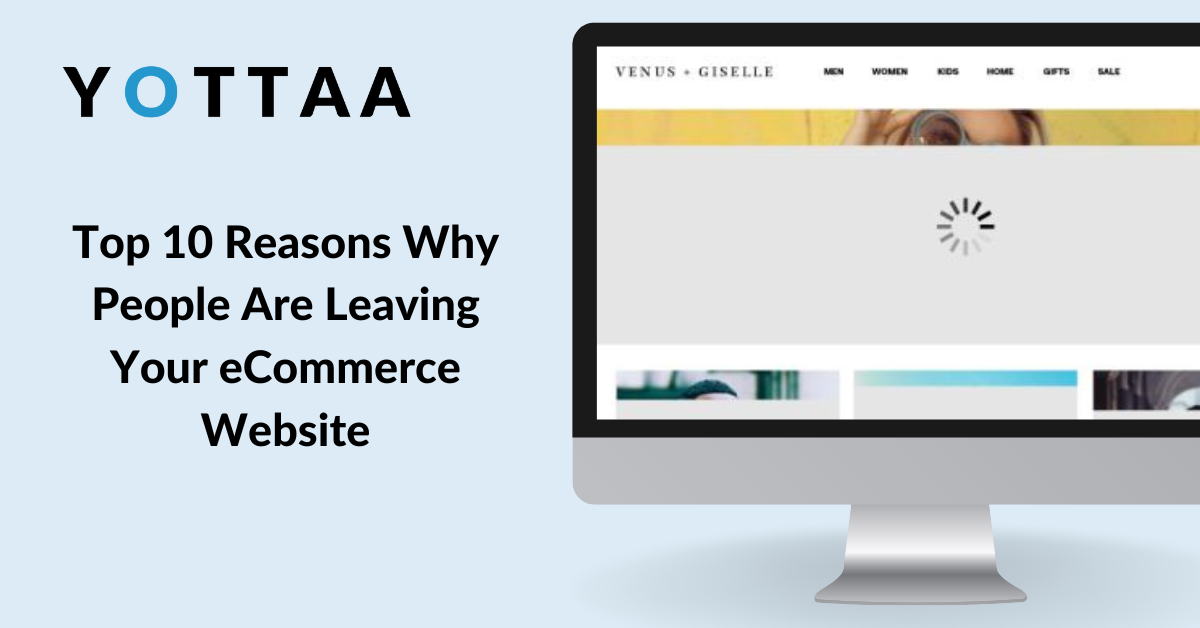Customers today expect fast results when coming to an eCommerce page. Without a positive browsing experience, keeping visitors on your website can be difficult. If your web applications are not appealing or engaging, then it’s likely will shop somewhere else. It is important to understand why users are deciding to leave your website.
Why Shoppers Leave Your eCommerce Website
1) Slow Page Load Times
The most common reason users leave a web page is that the pages take too long to load. Today web performance must be top-notch, in the range of four seconds or less, in order to meet user expectations. Unfortunately, the average display time for an eCommerce website remains around seven seconds. There are dozens of techniques to employ for performance, including optimizing images, and sequencing assets.
2) Over-Complicated Checkout
If you overcomplicate your checkout process, there’s an increased risk of abandoned shopping carts. If you’re requesting shoppers to fill out too many forms or perform too many complicated or repetitive actions, the customer will become impatient and abandon their cart. You can avoid this issue by making the process more visual and limiting the number of steps it takes to complete the checkout process.
3) Confusing Page Navigation
Simplicity is bliss. If a user finds your application too confusing to navigate you can kiss them goodbye. According to Joshua Adams of Rock Paper Simple, a web design, and development agency, “If you have to sit down and show your prospect how to navigate your site, you are doing it wrong! It should be easy and fast to navigate your site. Don’t let a confusing navigation ruin an otherwise great website.” While there’s something to be said for originality, there’s an even more compelling argument for giving users an experience that feels familiar and easy to use.
4) Poor Mobile Experience
Today’s online shopper is mobile-first. Brands that have made their web content mobile-friendly will rank higher on search engines and convert more browsers into buyers. than those that have not optimized for mobile. A mobile optimization is no longer an option; it is a part of life. Custora, among others, has found that one-third of all eCommerce purchases are now made on a smartphone. Use the best practices in our latest ebook to cater to mobile users and make your shopping experience mobile-friendly.
5) Lack of Customer Reviews
Online customers want to see what people are saying about your product or services. By not incorporating a customer review element on your application, you lose an opportunity for outside credibility and may appear to be hiding something. Using a customer review section will show that your organization is transparent and trustworthy and your products are legitimate. There are plenty of third party applications that provide this functionality, from written reviews to star ratings.
6) Stale and Outdated Content
Constantly updating your web application’s content is a good way to keep customers coming back for more. Leaving your older, stale content on your application will take away the legitimacy of your page, and can result in lower rankings on search engines. You want to show your visitors (and Google) that you are there for them with new and exciting information.
7) Audience Misalignment
In order to deliver fresh content that people want to see you must do customer research. It is hard to give your customers what they want if you don’t know what they want. There’s a phenomenon known to designers and developers as HiPPO — short for Highest Paid Person’s Opinion. When this is the driving force behind development it leads to assumptions about users that are often off-base since user behavior can be counter-intuitive. To counteract the HiPPO effect, any decisions you make, whether it is a design idea or content idea, must be based on research — whether its through analyzing the behavior of users on your current site, surveys, or A/B testing.
8) Lackluster Imagery
When you’re selling online, the imagery on your site really matters. The shopper can’t touch or try-on the products as they would in-store. So your imagery has to work hard to deliver on the same experience. Carousels of high-resolution product images with zoom-in functionality can help convince a shopper to load up their cart with your products. And these images need to be optimized for the mobile shopping experience, too.
9) Misguided Redirects
A critical element of the online shopping experience is browsing the way you want to browse. Redirects to pages that move a user down a path away from what they came to browse or buy will negatively impact conversion. Allow consumers to navigate your web store the way they want, don’t try to force them down a path. If visitors are not enjoying their user experience, they will leave your page before they make it to checkout.
10) Distracting Advertisments
Advertising space is important for your brand to expand shopper awareness of different products and offerings. But much like redirects, it’s important these ads don’t take away from the shopping experience. Disruptive, distracting ads might unintentionally divert someone away from the path to purchase they were on. Leverage subtle ways to advertise additional products, like “similar products” modules or discount available at certain spending thresholds.

